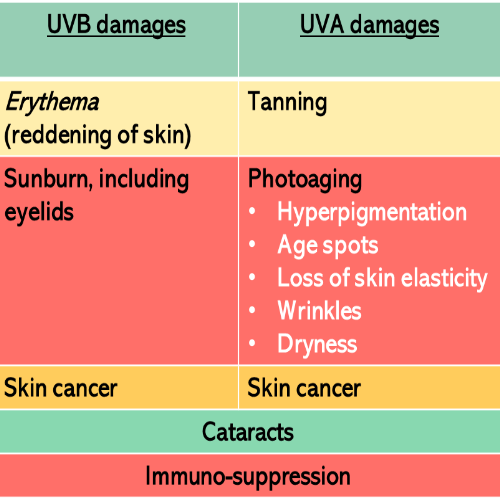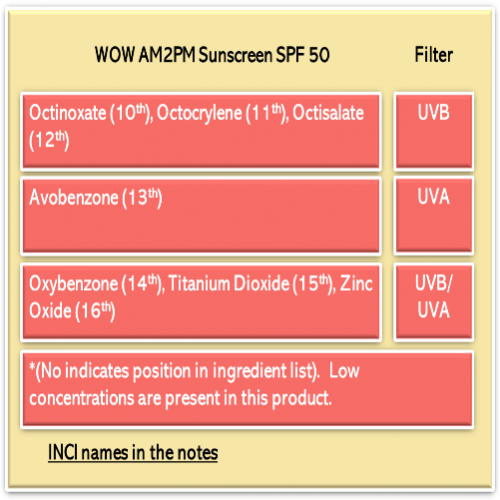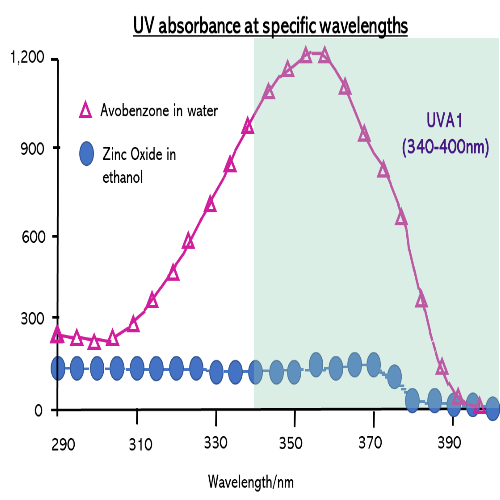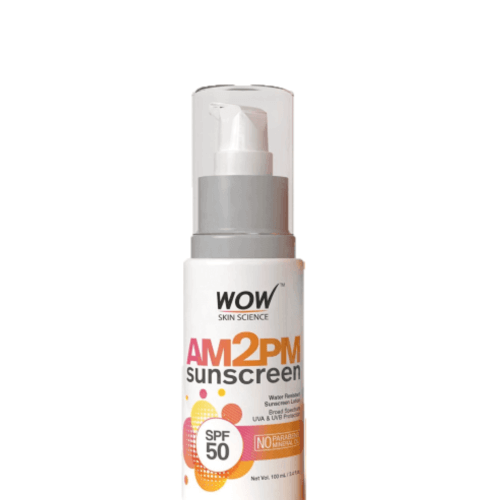10 second review
AM2PM follow a long line of Indian sunscreens that contain Avobenzone (a strong UVA filter) but fail to stabilise it. In plain English, there is no point buying sunscreen that does not provide proper protection against UVA* damage.
(*UVA damage => tanning and photogaging (hyper-pigmentation and wrinkles)…)
Happy Skin Days’ sunscreen test

Based on the above, you can give this product a miss.
1) Harmful chemical present is?
The harmful chemical is Benzophenone-3 (or Oxybenzone), a hormonal disruptor and a known skin-allergen.
(See also click Chemicals to Avoid – Oxybenzone)
P.S. Fun fact: in the European Union, Oxybenzone is an uncommon sunscreen ingredient probably because manufacturers must display “contains Benzophenone-3” on the label.
3a) Harmful effects of UVA and UVB
Both UVA and UVB have been definitively linked to photoaging and skin cancer. Its vital that sunscreens contain “UV filters” that protect our skin by absorbing, reflecting or scattering UVA and UVB rays.
The harmful effects of over-exposure to UVA and UVB are:

3b) Does this product contain UVA and UVB filters?
Yes. These are:

Without doubt this product contains sufficient UVB filters. In fact, WOW have thrown everything including the kitchen sink at this product.
But the problem lies with the UVA filters.
In my view, the product’s combination of filters does not provide sufficient protection against UVA damage.
3c) Avobenzone, that problem child
The primary UVA filter is Avobenzone. As I have indicated before it is a gold standard UVA filter. This is its absorbance compared to Zinc Oxide.
As you can see, it is in a league of its own.

However, available evidence shows Avobenzone degrades quickly upon exposure to sunlight, reducing its efficacy by as much as 50 and 90 per cent after 60 minutes of exposure.
This product does something very odd. It contains Octocrylene and Oxybenzone that stabilise Avobenzone. But it also contains Zinc Oxide, Titanium Dioxide and Octinoxate that make Avobenzone less photostable.
Studies show that Octinoxate makes itself and Avobenzone less effective UV absorbers. (Click on LINK for more information). Also, in the US, manufacturers are not permitted to combine Zinc Oxide and Titanium Dioxide because it makes Avobenzone unstable.
Closing remarks
I have not seen this combination in the 200+ sunscreens I have analysed. It’s very likely because the formulation does not do justice to Avobenzone. Pass on it.
That’s it from me (for today). Please let me know if you have any queries or I’d love to hear your suggestions so please write to me. Click on “EMAIL ME” for my address. I look forward to hearing from you!
See also Top 5 Sunscreen Recommendations, Do You Know Your Filters?, Guide to Buying Sun Protection, Do You Understand The Gibberish on Sunscreen Labels?
INCI names
- Ethylhexyl Methoxycinnamate (or Octinoxate)
- Butylmethoxy dibenzoylmethane (or Avobenzone)
- Benzophenone-3 (or Oxybenzone)
Sources and uses:
US20170326062A1 (US Patent application pending)
US9956163B2 (Having previously been published, pre-grant publication)
Ceresole, R., Y.K. Han, M.A. Rosasco, et al., “Drug-Excipient Compatibility Studies in Binary Mixtures of Avobenzone,” Journal of Cosmetic Science, vol. 64(5), pp. 317-328, 2013.
Nash, J.F., and P.R. Tanner, “Relevance of UV Filter/Sunscreen Product Photostability to Human Safety,” Photodermatology, Photoimmunology and Photomedicine, vol. 30(2-3), pp. 88-95, 2014
Roberts, Jiang, Herndon, Jr, “Facial primer provides immediate and long-term improvements in mild-to-moderate facial hyperpigmentation and fine lines associated with photoaging” Clin Cosmet Investig Dermatol. 2015; 8: 471–477
